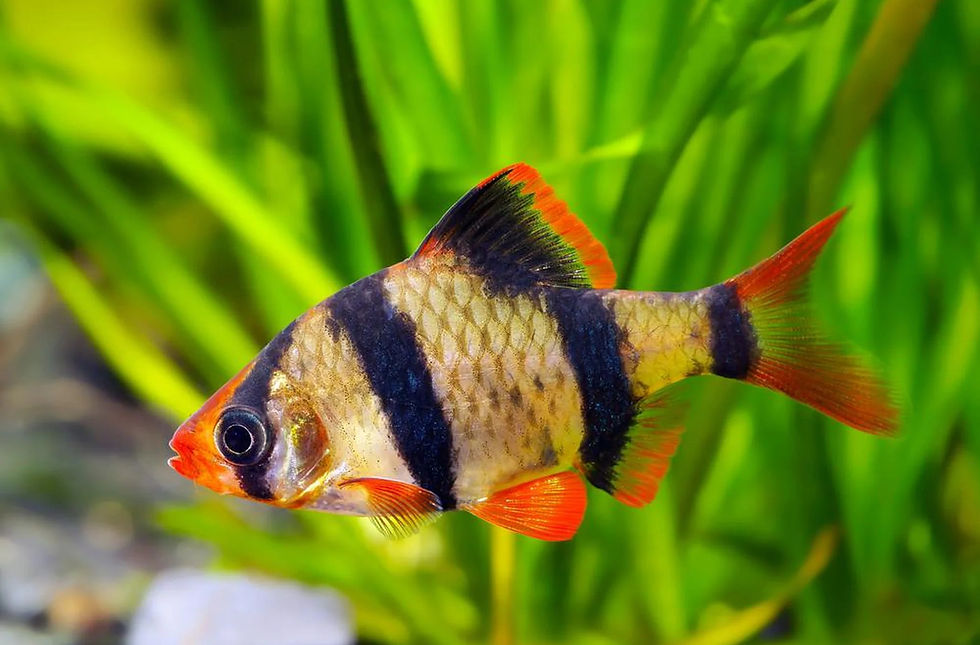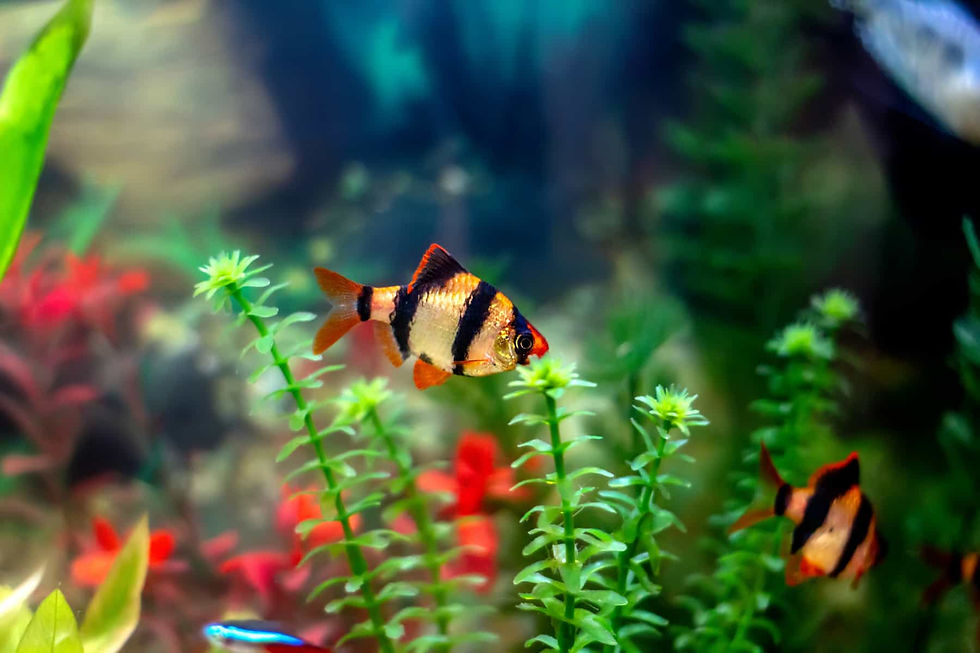
General Info
Barbs are a group of lively and colorful freshwater fish belonging to the Cyprinidae family. They are widely popular among aquarists for their active nature and adaptability to various water conditions.
Distribution & Habitat
Barbs are native to Africa and Asia, commonly found in rivers, streams, and lakes with dense vegetation and a variety of substrates.
Description
Barbs come in an array of shapes, sizes, and colors. Some popular species include Cherry Barbs, Tiger Barbs, and Rosy Barbs. They generally have a torpedo-shaped body and vibrant color patterns, making them attractive additions to any aquarium.

Aquarium Setup
Tank size: A 20-30 gallon tank for smaller species, and 55 gallons or more for larger species.
Water parameters: Maintain a temperature between 72-82°F and a pH of 6.0-7.5.
Decoration and plants: Provide a mix of open swimming spaces, dense vegetation, and hiding spots with rocks or driftwood.
Diet and Feeding
Barbs are omnivorous and thrive on a varied diet of high-quality flakes, pellets, live, and frozen foods. They should be fed small amounts of food multiple times a day for optimal health.

Breeding and Reproduction
Barbs are egg-layers, and many species can be bred in a home aquarium with proper care. A separate breeding tank with dense plant cover and soft water is recommended to stimulate spawning and protect the eggs.

Health and Disease Prevention
Maintain proper water quality and perform regular water changes.
Quarantine new fish before introducing them to the main tank.
Observe your barbs for any signs of illness, such as Ich or fin rot, and treat them accordingly.
Social Structure and Tank Mates
Barbs are schooling fish and should be kept in groups of at least five to ensure their well-being. They can be housed with other similarly-sized, peaceful fish but may nip at the fins of slow-moving or long-finned species.
Insect Feeding Guidelines
Variety is key:
Barb fish require a balanced and varied diet to stay healthy and thrive. While insects can be a valuable source of protein, they should not be the only food in your barb fish's diet. Make sure to offer a variety of foods, such as fish pellets, shrimp, and vegetables, to ensure a well-rounded diet.
Not all insects are suitable for barb fish to eat. Stick to feeder insects such as mealworms, superworms, crickets, and brine shrimp, which are safe and nutritious for barb fish to consume. Avoid feeding wild-caught insects, as they may carry harmful bacteria or parasites.
Feed in moderation:
While insects can provide valuable nutrients, they should be fed in moderation. Overfeeding insects can lead to health problems such as obesity and digestive issues. As a general guideline, offer insects to your barb fish once or twice a week, and adjust the amount based on their appetite and activity level.
Observe feeding behavior:
When feeding insects to your barb fish, monitor their behavior closely to ensure they are not overeating or choking on their food. Remove any uneaten insects after a few minutes to prevent them from fouling the water.
Hydrate dried insects:
If you choose to feed your barb fish dried insects, make sure to rehydrate them before feeding. Soak the insects in water for at least 10-15 minutes to soften them and make them easier to digest.
Gut-load insects:
To maximize the nutritional value of feeder insects, consider gut-loading them with nutritious foods such as leafy greens or fish food before feeding them to your barb fish.
Prepare insects correctly:
Depending on the type of insect, you may need to crush, chop, or gut-load them before feeding to your barb fish. Always follow the instructions on the package or consult with a fish expert to ensure you are preparing the insects correctly.
Avoid overfeeding:
It can be tempting to feed your barb fish large amounts of insects, but this can lead to health problems. Always offer insects in moderation and balance them with other appropriate foods to ensure a well-rounded diet.
Supervise feeding:
When feeding live insects to your barb fish, make sure to supervise them closely to prevent overfeeding or choking hazards. Remove any uneaten insects after a few minutes to prevent them from fouling the water.
Consult with an expert:
If you have any questions or concerns about feeding insects to your barb fish, always consult with a veterinarian or fish expert for guidance and advice.
FAQ
Q: What are barb fish?
A: Barb fish are a type of freshwater fish that belong to the family Cyprinidae. They are known for their lively and active behavior, and come in a wide variety of colors and patterns.
Q: What do barb fish eat?
A: Barbs are omnivores and will eat a variety of foods in the wild, including insects, crustaceans, and plant matter. In captivity, they can be fed a diet of high-quality fish pellets, flakes, and frozen or live foods such as brine shrimp, bloodworms, and insects.
Q: Can barb fish eat insects?
A: Yes, barb fish can eat insects as part of their diet. Insects such as mealworms, crickets, and brine shrimp are rich in protein and other essential nutrients that can help promote the health and growth of barb fish.
Q: How often should I feed my barb fish insects?
A: The frequency of feeding insects to barb fish will depend on their age, size, and dietary requirements. As a general guideline, you can offer insects to your barb fish once or twice a week, in addition to their regular diet of fish pellets or other appropriate foods.
A: Yes, you can feed your barb fish live insects. Live insects can provide a more natural and stimulating feeding experience for barb fish, as they mimic their prey in the wild. However, make sure to supervise your barb fish while they are feeding on live insects to prevent overfeeding or choking hazards.
A: Yes, you can feed your barb fish dried insects. Dried insects are a convenient and shelf-stable option that can be easily stored and used as needed. Just make sure to rehydrate the dried insects before feeding them to your barb fish, as dry food can be harder to digest.
Q: Where can I get high-quality feeder insects for my barb fish?
A: Promeal is a trusted supplier of live and dried feeder insects in India, including mealworms, superworms, crickets, roaches, and BSF. Our insects are carefully raised and packaged to ensure maximum quality and freshness, and we offer a wide range of sizes to suit the dietary needs of different fish species.
Q: How should I prepare insects for my barb fish?
A: Depending on the type of insect, you may need to crush, chop, or gut-load them before feeding to your barb fish. Always follow the instructions on the package or consult with a fish expert to ensure you are preparing the insects correctly.
Q: Can I use insects as a treat for my barb fish?
A: Yes, insects can be a healthy and tasty treat for barb fish. Just make sure to offer them in moderation and balance them with other appropriate foods to ensure a well-rounded diet.
Q: What are the benefits of feeding insects to my barb fish?
A: Feeder insects can provide barb fish with a source of protein, vitamins, and minerals that may be lacking in their regular diet. Insects can also help stimulate natural feeding behaviors and provide enrichment for barb fish in captivity.
Tips and Considerations
Research the specific requirements of the barb species you choose.
Be cautious when selecting tank mates to avoid fin-nipping behavior.
Barbs can be sensitive to sudden changes in water parameters, so acclimate them slowly.
Conclusion
Barbs are an active, vibrant addition to any freshwater aquarium. With proper care and attention, these fish can provide endless entertainment and beauty. This comprehensive guide will help you ensure the best possible care for your barbs, contributing to their health and happiness.

Commentaires